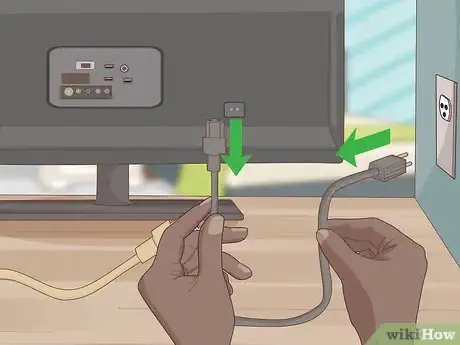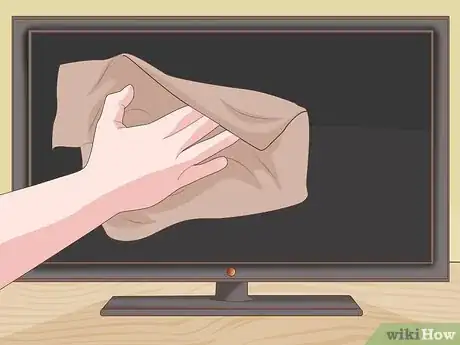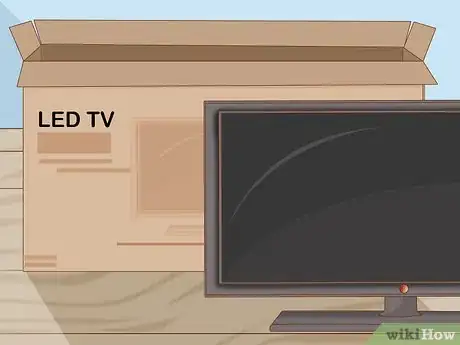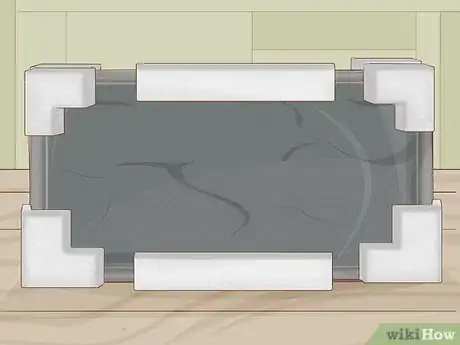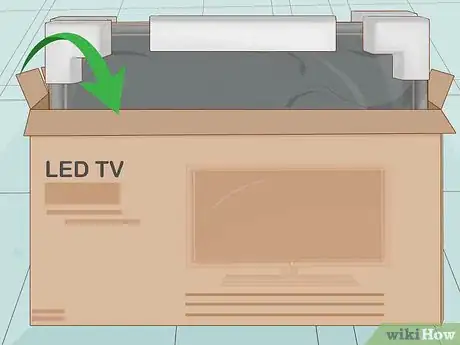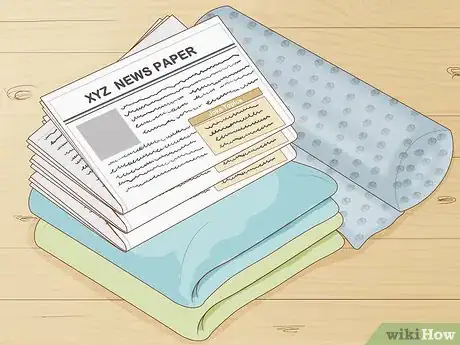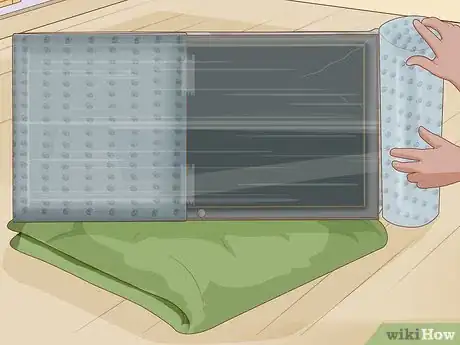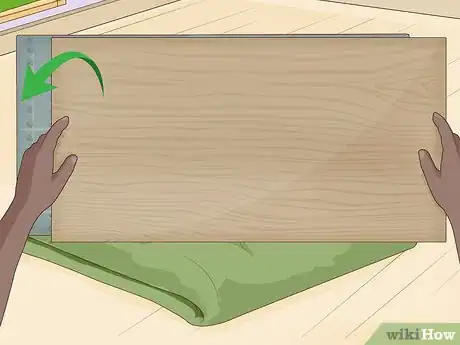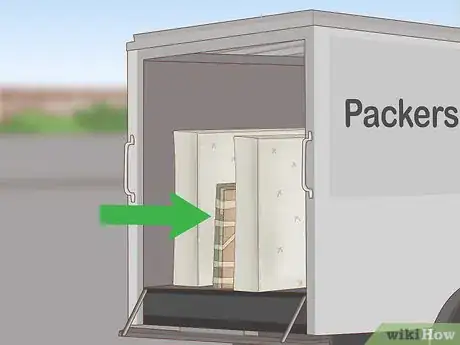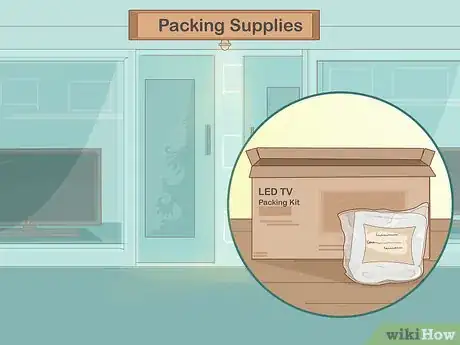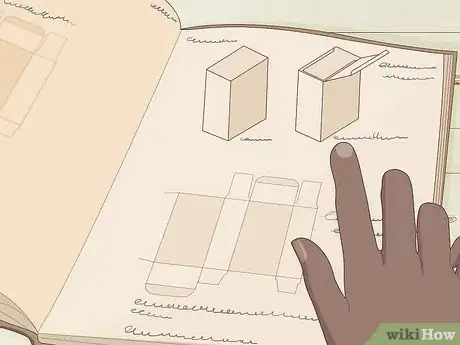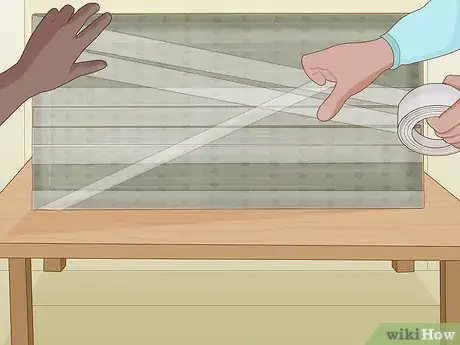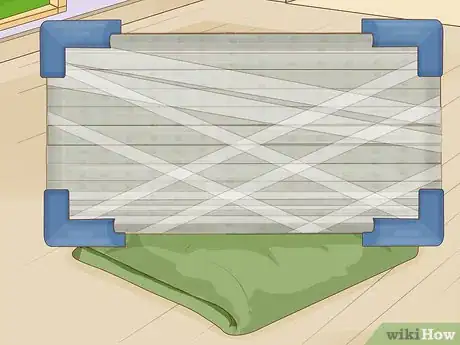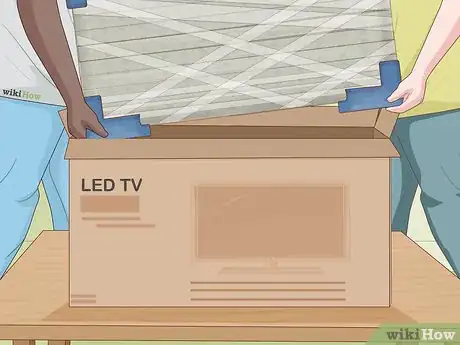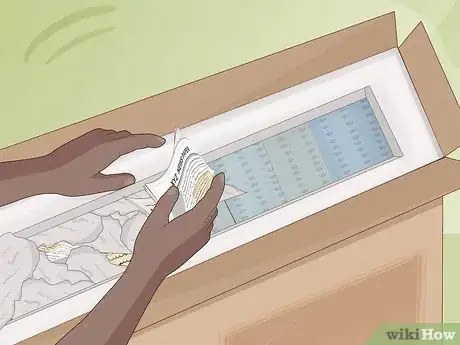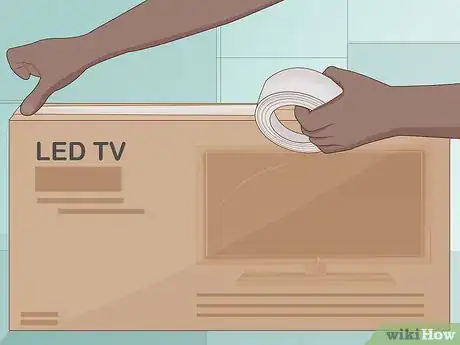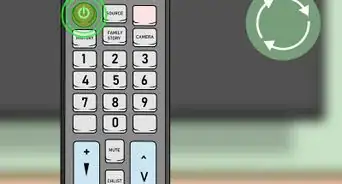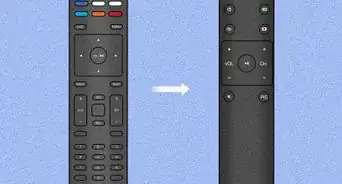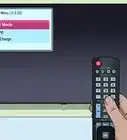This article was co-authored by Marty Stevens-Heebner, SMM-C, CPO®. Marty Stevens-Heebner is a Certified Professional Organizer (CPO) and Founder of Clear Home Solutions, a home organizing and senior moving management company based in southern California. Marty is the first Certified Senior Move Manager (SMM-C) in the United States and is a Certified Aging in Place Specialist (CAPS) through the National Association of Home Builders. She is the President-Elect and is on the board of directors of the National Association for Senior Move Managers, a member of the National Association of Professional Organizers, and has been acknowledged as a Hoarding Specialist and ADHD Specialist through the Institute for Challenging Disorganization.
This article has been viewed 51,422 times.
When moving, it is important to pack your belongings securely. Your TV is an item that needs special attention during packing because it is fragile. You need to prepare it properly and use the right materials to protect it, including cushioning and cardboard. With some care, your TV can be packed and transported to its new home safely.
Steps
Preparing Your TV for Packing
-
1Remove any accessories and cords. When getting your TV ready to be packed, you should first unplug the TV and remove the power cord from the TV, if possible. Then remove the cords that attach any accessories, such as streaming devices or DVD players. Coil them up and tie the coil together with a rope or ribbon.[1]
- Leaving cords attached to your TV can cause the cords or the cord attachment points on the TV to be damaged during moving.
- If you have a lot of components and cables, it's a good idea to label them before you pack them.[2] Put a piece of tape around the cord and write what the cord is used for on the tape. This will make it easier to put your TV system back together once your move is over.
- Put the cords in a separate box or in the box you are using to pack up your components. Putting them in the same box as the TV could damage it if they move around.
- Wrap up attached cords. If there are cords that can't be detached from the TV, you should wrap them up neatly. You don't have to wrap up the cords all the way to the TV. You simply need to wrap up the majority of the cord so it can be contained and won't be a tripping hazard while you are packing up the TV.
-
2Clean your TV with a microfiber cloth. Take the time to clean all the dust and debris off of your TV before you pack it up. Not only will this help keep you clean as you move the TV, dust, and dirt left on the screen could scratch it while shifting during moving.[3]Advertisement
-
3Unmount your TV. If your TV is mounted on a wall, it needs to be taken down. Typically, you will first detach the TV from the bracket and then take the bracket off the wall after the TV is removed. Look at the instructions for the mounting bracket if you are unsure about how to detach the TV.[4]
- If your TV is large, it's a good idea to have someone help you take it down. Even if the TV is relatively light, a large TV can be awkward to handle by yourself.
- If your TV sits on a base, this should also be detached from the TV in order to pack it effectively. This typically requires the use of a screwdriver.[5]
Putting Your TV in its Original Packaging
-
1Keep all packaging when you purchase your TV. When you purchase a new TV, it's a good idea to keep all of its packaging so you can use it for future moves. A TV's packaging is specially made to protect it, so using the original packaging is the easiest and most effective way to protect it during a move.[6]
-
2Place protective cushioning on the TV. Remove all of the protective packaging inside the box and put it back on your TV. The packaging was made specifically for your TV, so it should fit perfectly.[7]
- You may have to play around with the foam or cardboard protective pieces that cushion the TV. Take your time and just make sure that they are placed on the TV correctly.
-
3Put the TV in the box. Slide the TV into the box and make sure it is placed correctly. If it is, it should not move around much when the box is closed. Once the box is closed up, seal it with tape.
- Some TV boxes can be closed with tabs and do not need to be taped shut. However, without tape, there is always a chance of the TV coming out of the box on accident.
Wrapping a TV in Packing Materials
-
1Collect soft wrapping materials. Collect a variety of soft wrapping materials you can use to pad the TV. These can include bubble wrap, newspaper, and moving blankets.[8] [9]
- In many cases, you can use materials that you are already going to move, such as blankets, clothes, and other linens. They can pad your TV and get moved in the process, and then you don't have to spend extra money buying additional packing materials.
-
2Wrap the whole TV in cushioning. Wrap the TV in the soft packing materials you have found. Once the whole TV is totally wrapped, tape the padding in place. Wrapping the entire TV before taping ensures that the tape does not get on the TV, which could damage the screen.[10]
-
3Place heavier protection over the face of the TV. Once you have cushioned the face of the TV, it's a good idea to put a harder layer of protection on top of the cushioning. Use a piece of cardboard or thin plywood to protect the face of the TV. Regardless of whether you have a flat screen TV or another type, you should measure the entire front. Then cut the cardboard to size and tape it on the TV by wrapping tape all the way around it.[11]
- If you have a large TV, you may need to use several pieces of cardboard to cover the face of the TV.
- You can use the cardboard from a flattened moving box or any spare plywood you have around.
- If you can, construct a makeshift box out of pieces of cardboard. This will protect the TV more effectively than just protecting the front of it.
-
4Move the TV carefully. If you haven't put your TV in a secure box, you need to be careful when moving it. Make sure that it is in a very protected spot in your moving truck, such as next to a mattress or other soft surface.
- You may even want to take the TV and move it in your own car. Taking it in the back seat of your car will help ensure that it gets to its destination safely.
Using a TV Packing Kit
-
1Purchase a packing kit. If you do not have the original packaging for your TV, you can buy a packing kit that is specially made for packing TVs. These are available from most moving companies and at many home improvement stores.[12]
- Packing kits typically include a box that can hold TVs in a range of sizes. Look at the packaging before you buy the kit to make sure your TV will fit in it.
- Kits should include a box and corner cushioning for the TV. They may also include padding, such as bubble wrap.
-
2Read the directions included. Each type of packing kit will have slightly different directions. Read your kit's directions before starting packing and follow them in order to protect your TV from damage.
-
3Wrap the TV in padding. It is a good idea to wrap your TV in a protective layer before putting it in a box. This protective layer can consist of soft padding, such as a thin blanket, or packing material, such as bubble wrap.
- Use a thin layer of padding before putting the corner protectors on so you can be sure that they will fit over the padding.
-
4Place corner protectors on the TV. Your packing kit should come with corner protectors that fit over the corners of your TV. There will be 4 included and they should be adjustable to fit a variety of sizes of TVs. Follow the directions for how to put them on your TV.
-
5Put the TV in the box. Once the corner protectors are in place you should slide your TV into its box. Many packing kits come with a 2-part box in order to fit a variety of sizes of TVs. Place your TV in 1 box piece and then slide the second piece on over the first.
-
6Fill empty space with cushioning. Because packing kits are made to fit many different TVs, there may be a lot of empty space in the box. Try filling this space with packing material, such as newspaper or bubble wrap, to ensure that your TV is kept secure.[13]
- If there is a lot of extra space, try using a moving blanket or small cushion to fill up the space.
-
7Tape the packaging closed. Once your TV is properly packed, you can seal up the box. Make sure the box is thoroughly taped so that the box will stay intact even if it is moved around and jostled in transit.
Expert Q&A
Did you know you can get expert answers for this article?
Unlock expert answers by supporting wikiHow
-
QuestionHow can I move a large TV without the box?
 Marty Stevens-Heebner, SMM-C, CPO®Marty Stevens-Heebner is a Certified Professional Organizer (CPO) and Founder of Clear Home Solutions, a home organizing and senior moving management company based in southern California. Marty is the first Certified Senior Move Manager (SMM-C) in the United States and is a Certified Aging in Place Specialist (CAPS) through the National Association of Home Builders. She is the President-Elect and is on the board of directors of the National Association for Senior Move Managers, a member of the National Association of Professional Organizers, and has been acknowledged as a Hoarding Specialist and ADHD Specialist through the Institute for Challenging Disorganization.
Marty Stevens-Heebner, SMM-C, CPO®Marty Stevens-Heebner is a Certified Professional Organizer (CPO) and Founder of Clear Home Solutions, a home organizing and senior moving management company based in southern California. Marty is the first Certified Senior Move Manager (SMM-C) in the United States and is a Certified Aging in Place Specialist (CAPS) through the National Association of Home Builders. She is the President-Elect and is on the board of directors of the National Association for Senior Move Managers, a member of the National Association of Professional Organizers, and has been acknowledged as a Hoarding Specialist and ADHD Specialist through the Institute for Challenging Disorganization.
Certified Professional Organizer & Senior Move Manager Certified Professional Organizer & Senior Move ManagerExpert Answer
Certified Professional Organizer & Senior Move ManagerExpert Answer
References
- ↑ https://www.bestbuy.com/site/clp/how-to-pack-move-your-tv/pcmcat362000050008.c?id=pcmcat362000050008
- ↑ Marty Stevens-Heebner, SMM-C, CPO®. Certified Professional Organizer & Senior Move Manager. Expert Interview. 14 January 2020.
- ↑ https://www.bestbuy.com/site/clp/how-to-pack-move-your-tv/pcmcat362000050008.c?id=pcmcat362000050008
- ↑ https://www.bestbuy.com/site/clp/how-to-pack-move-your-tv/pcmcat362000050008.c?id=pcmcat362000050008
- ↑ https://www.uhaul.com/Articles/Tips/7114/How-To-Pack-And-Move-Your-Flat-Screen-Tv/
- ↑ https://www.bestbuy.com/site/clp/how-to-pack-move-your-tv/pcmcat362000050008.c?id=pcmcat362000050008
- ↑ https://www.bestbuy.com/site/clp/how-to-pack-move-your-tv/pcmcat362000050008.c?id=pcmcat362000050008
- ↑ Marty Stevens-Heebner, SMM-C, CPO®. Certified Professional Organizer & Senior Move Manager. Expert Interview. 14 January 2020.
- ↑ http://www.move.org/blog/moving-packing-electronics
